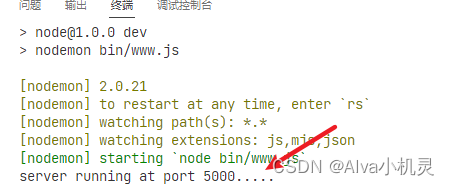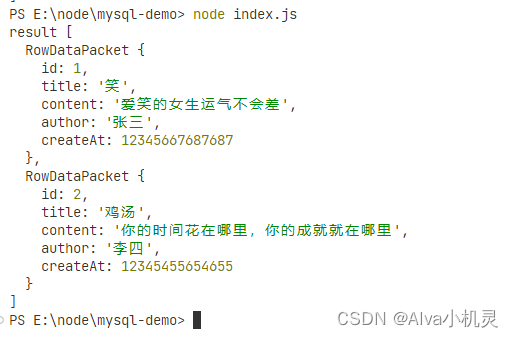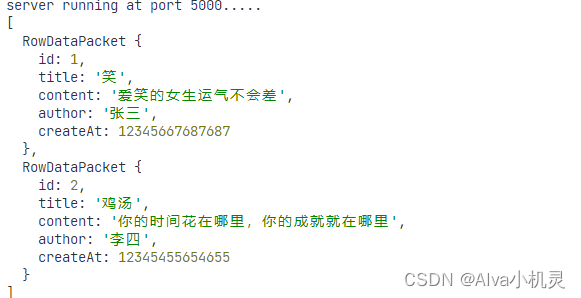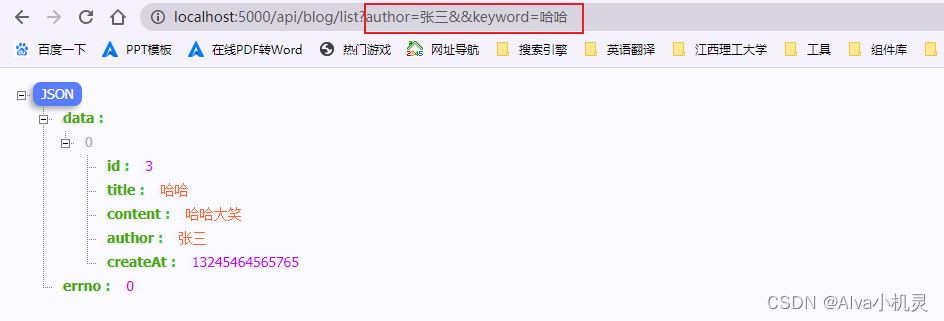一.搭建开发环境
1.创建一个空文件夹,在vscode中打开
2.开启package文件,因为需要用到npm包
**npm init -y **
3.创建bin文件夹,也就是程序运行最开始访问的文件夹
4.www.js创建服务器
//创建服务器const http = require('http');//将服务器回调函数引入const serverHandler = require('../app')//端口const PORT = 5000;const server = http.createServer(serverHandler);server.listen(PORT, () => {// 监听成功执行的回调console.log('server running at port 5000.....');})
将回调函数单独抽离出来,放在根目录文件app.js
//写回到函数,将createServer中的回调函数抽离了出来,目的是更好的维护const serverHandler = (req, res) => {//这里面是服务器的业务代码//1.设置返回的数据类型res.setHeader('Content-Type', 'application/json')//2.数据格式const responseData = {name: 'alva',age: 21}res.end(JSON.stringify(responseData))}module.exports = serverHandler;
5.启动服务器
**5.1启动前,将package.json中的main属性修改成bin/www.js设置启动入口**
** 5.2安装工具 **
** npm install nodemon -D**
5.3修改
"scripts": {
** "dev": "nodemon bin/www.js"**
** },**
当服务器代码发生改变时重新运行最新的代码
** 5.4.启动服务器**
** npm run dev**

6.在浏览器输入 http://locsalhost:5000

以上开发环境就已经搭建好了
二.路由配置
1.根目录创建src下的routes文件夹,里面创建blog.js文件
//处理博客相关的路由,定义处理路由的逻辑const handleBlogRoute = (req, res) => {const method = req.method;const url = req.url;const path = url.split('?')[0] //问号分割取前半段//如果请求如下就返回下面的结果,这个结果会保存到blogDataif (method === 'GET' && path === '/api/blog/list') {return {message: '获取博客列表的接口'}}}module.exports = handleBlogRoute;
接着在服务器的业务代码中接收这个数据
res.setHeader('Content-Type', 'application/json')//路由返回数据结果(将请求和响应传入)const blogData = handleBlogRoute(req, res)if (blogData) {//如果拿到了,就结束请求,返回一个响应res.end()}
注意: 上面的代码中blogData是一个对象 ,但是服务器返回给浏览器的应该是字符串,所以应该进行转换
if (blogData) {//如果拿到了,就结束请求,返回一个响应res.end(JSON.stringify(blogData));//响应之后,下面的代码不再执行,所以return一下return;}
**现在我们已经定义好了一个接口,就是 /api/blog/list**
我们尝试在浏览器进行访问

前端拿到这样的字符串就可以进行解析渲染到页面上
2.定义多个接口
if (method === 'GET' && path === '/api/blog/detail') {return {message: '获取博客详情的接口'}}if (method === 'POST' && path === '/api/blog/new') {return {message: '新建博客的接口'}}if (method === 'POST' && path === '/api/blog/update') {return {message: '更新博客的接口'}}if (method === 'POST' && path === '/api/blog/delete') {return {message: '删除博客的接口'}}
**2.2测试接口**
对于post请求的接口,由于请求体比较大,我们可以使用postman 或者apifox工具进行测试

3.处理错误请求
if (blogData) {//如果拿到了,就结束请求,返回一个响应res.end(JSON.stringify(blogData));//响应之后,下面的代码不再执行,所以return一下return;}//如果不是上面的路由,就会返回下面的结果res.writeHead(404, { 'Content-Type': 'text/plain' }); //无格式正文res.write('404 Not Found');res.end(); //终止响应

4.改造
这个handleBlogRoute只是关于博客的请求处理,如果我们还有别的路由请求需要处理可以进行如下操作
将下面的部分放到 服务器业务代码返回数据之前
const url = req.url;const path = url.split('?')[0] //问号分割取前半段
放入后做改造
const url = req.url;req.path = url.split('?')[0] //问号分割取前半段
在进行请求判断时,应该使用下面的写法
req.path==='/api/xxx'
三.响应数据格式优化
创建src目录下面的model文件夹,里面新建一个responseModel.js
class BaseModel {//构造函数constructor(data, message) {//数据可能是对象或者string,如果是string,直接message返回if (typeof data == 'string') {this.message = datadata = nullmessage = null}if (data) {this.data = data}if (message) {this.message = message}}}//根据基类,下面是成功与失败的模型class SuccessModel extends BaseModel {constructor(data, message) {super(data, message)this.errno = 0;}}class ErrorModel extends BaseModel {constructor(data, message) {super(data, message)this.errno = -1;}}module.exports = {SuccessModel,ErrorModel}
获取blog列表接口修改示例
**接口:**
/api/blog/list?author = zhansan&keyword=123
1.先拿到参数
req.path = url.split('?')[0] //问号分割取前半段//解析queryreq.query = querystring.parse(url.split('?')[1]);
2.返回数据改造
//如果请求如下就返回下面的结果,这个结果会保存到blogDataif (method === 'GET' && req.path === '/api/blog/list') {const author = req.query.author || '';const keyword = req.query.keyword || '';const listData = getList(author, keyword); //根据参数获取数据return new SuccessModel(listData)// return {// message: '获取博客列表的接口'// }}
3.src下创建controller包,新建一个blog.js文件
//博客相关的方法const getList = (author, keyword) => {//从数据库里面拿数据//先做假数据return [{id: 1,title: '标题一',content: '内容一',author: '张三',createAt: 161055518935 //date.now()获取的时间戳},{id: 2,title: '标题二',content: '内容二',author: '李四',createAt: 161055535044 //date.now()获取的时间戳}]}module.exports = {getList}
4.测试

四.异步处理post请求数据
const querystring = require('querystring')const handleBlogRoute = require('./src/routes/blog')//处理post数据const getPostData = (req) => {const promise = new Promise((resolve, reject) => {if (req.method !== 'POST') {resolve({})return;}if (req.headers['content-type'] !== 'application/json') {resolve({})return;}let postData = ''//返回的是数据段req.on('data', (chunk) => {postData += chunk.toString();})req.on('end', () => {if (!postData) {resolve({})return;}resolve(JSON.parse(postData))})})return promise;}//这里面是服务器的业务代码const serverHandler = (req, res) => {//设置返回的数据类型(响应格式)res.setHeader('Content-Type', 'application/json')//获取pathconst url = req.url;req.path = url.split('?')[0] //问号分割取前半段//解析queryreq.query = querystring.parse(url.split('?')[1]);//下面的函数返回的是一个promise,这是一个异步的过程,意思是这个还没走完代码就会往下执行别的步骤,//这样可能会导致有些路由访问不到,因为数据还没处理完getPostData(req).then((postData) => {req.body = postData//路由返回数据结果(将请求和响应传入)const blogData = handleBlogRoute(req, res)if (blogData) {//如果拿到了,就结束请求,返回一个响应res.end(JSON.stringify(blogData));//响应之后,下面的代码不再执行,所以return一下return;}//如果不是上面的路由,就会返回下面的结果res.writeHead(404, { 'Content-Type': 'text/plain' }); //无格式正文res.write('404 Not Found');res.end(); //终止响应})}module.exports = serverHandler;module.exports = serverHandler;
**例如更新博客的路由**
const handleBlogRoute = (req, res) => {const id = req.query.idconst blogData = req.bodyconst method = req.method;//如果请求如下就返回下面的结果,这个结果会保存到blogDataif (method === 'POST' && req.path === '/api/blog/update') {const updatedBlogData = updatedBlog(blogData)if (updatedBlogData) {return new SuccessModel('更新博客成功')}// return {// message: '更新博客的接口'// }}}
上面的操作中,因为许多接口请求时都用到了id和数据,所以将它们提取出来
**方法**
//更新博客 blogData = {}是设置空对象,防止没有传const updatedBlog = (id, blogData = {}) => {console.log('id', id);console.log('blogData', blogData);return true}

五.使用MySQL
1.在数据库中新建一个数据库,并创建blogs表


2.nodejs连接mysql-一个测试demo
1.创建index.js

2.终端进入mysql-demo
** npm init -y**
** npm install mysql**
3.index.js实现连接数据库
const mysql = require('mysql')//创建连接对象const connection = mysql.createConnection({host: 'localhost',user: 'root',password: '123456','port': 3306,database: 'myblog'})//开始连接connection.connect();//执行sql语句const sql = `select * from blogs`connection.query(sql, (err, result) => {if (err) {console.error('error', err)return;}console.log('result', result);})//关闭连接connection.end()
** 4.终端输入node index.js**

3.封装执行sql语句的工具函数
**src下面创建db文件夹,新建mysql.js文件**
** 终端输入 **
PS E:\node> **npm install mysql****mysql.js**
const mysql = require('mysql')//创建连接对象const connection = mysql.createConnection({host: 'localhost',user: 'root',password: '123456','port': 3306,database: 'myblog'})//开始连接connection.connect();//执行sql语句的函数function execSQL(sql) {const promise = new Promise((resolve, reject) => {connection.query(sql, (err, result) => {if (err) {reject(err)return;}resolve(result)})})return promise;}module.exports = {execSQL}
测试获取列表接口
if (method === 'GET' && req.path === '/api/blog/list') {const sql = `select * from blogs`execSQL(sql).then(result => {console.log(result);})const author = req.query.author || '';const keyword = req.query.keyword || '';const listData = getList(author, keyword); //根据参数获取数据return new SuccessModel(listData)// return {// message: '获取博客列表的接口'// }}
访问路由,控制台输出

完善请求接口
const handleBlogRoute = (req, res) => {const id = req.query.idconst blogData = req.bodyconst method = req.method;//如果请求如下就返回下面的结果,这个结果会保存到blogDataif (method === 'GET' && req.path === '/api/blog/list') {const author = req.query.author || '';const keyword = req.query.keyword || '';const listData = getList(author, keyword); //根据参数获取数据,这里返回的是一个promise对象return listData.then(listData => {return new SuccessModel(listData)})}
//博客相关的方法const getList = (author, keyword) => {//从数据库里面拿数据(根据用户以及关键字)//由于我们要做拼接,改成letlet sql = `select * from blogs where`if (author) {sql += ` author = '${author}' `}if (keyword) {sql += `and title like '%${keyword}%' ` //模糊查询}return execSQL(sql)}
接下来在app.js文件中使用了handleBlogRoute的地方修改返回结果代码
req.body = postData//路由返回数据结果(将请求和响应传入)const blogData = handleBlogRoute(req, res)if (blogData) {//这是一个promise对象blogData.then(blogData => {//如果拿到了,就结束请求,返回一个响应res.end(JSON.stringify(blogData));})//响应之后,下面的代码不再执行,所以return一下return;}



注意 如果我们没有输入参数,会报错,因为我们的sql语句中where后面没有内容,语句错误,为避免这样的问题,我们可以进行下面的小技巧
let sql = `select * from blogs where 1=1`

版权归原作者 亦菲小机灵 所有, 如有侵权,请联系我们删除。